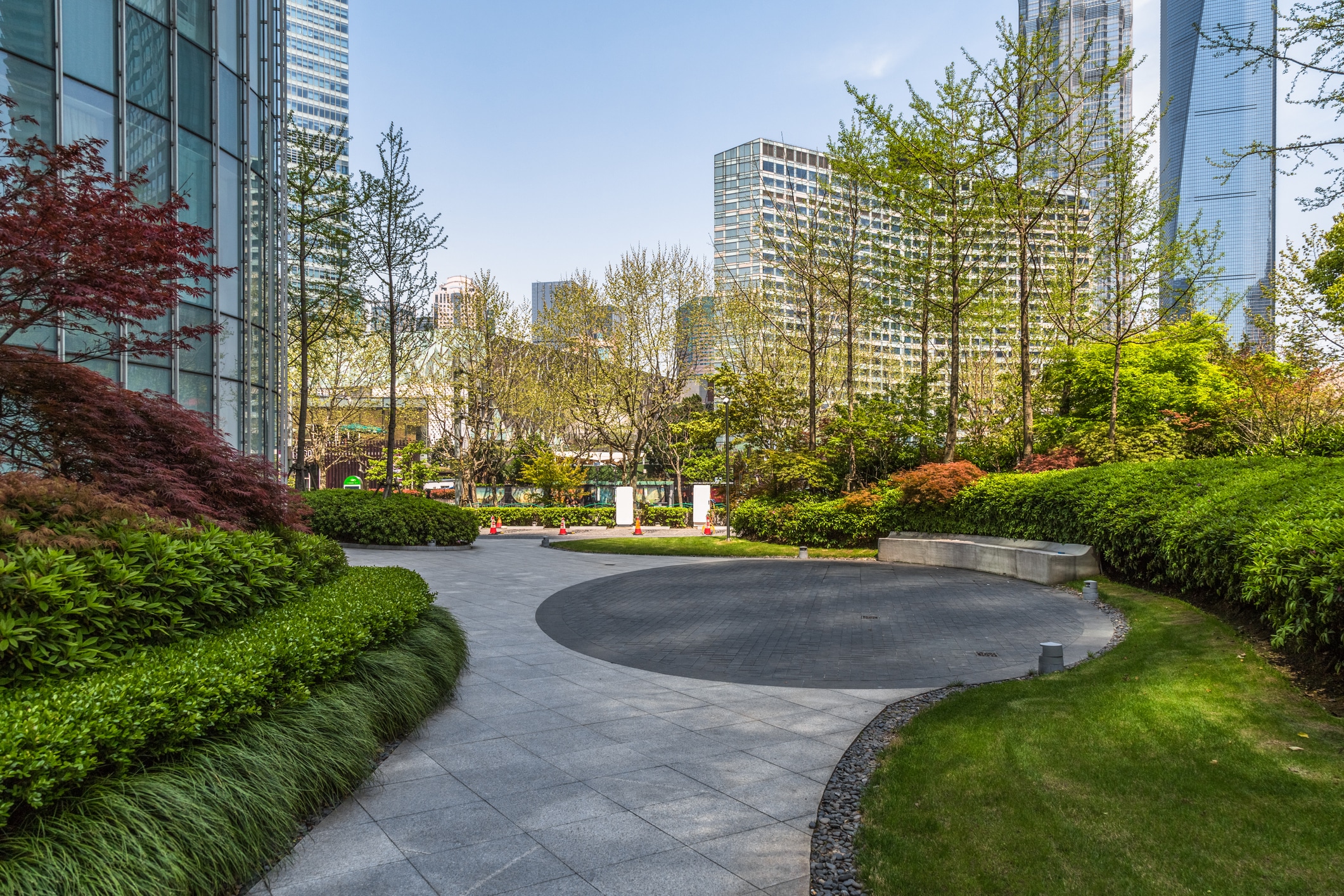Commercial renovation projects often include conversations about energy efficiency and sustainability, but it can be…

Eco-Friendly Materials: Building Commercial Spaces with a Lower Carbon Footprint
Green construction is more than a buzzword, it’s an active commitment to reducing the carbon footprint of every commercial project. From recycled-content steel to low-carbon concrete alternatives, eco-friendly choices can cut greenhouse gas emissions, improve indoor air quality, and deliver long-term savings for building owners.
Here, we’ll look at why reducing commercial carbon footprint is important and what benefits it can bring to your organization. As a leading commercial contractor in Michigan, we integrate sustainable materials and innovative practices to build healthier, longer-lasting spaces.
Why Sustainable Materials Matter in Commercial Construction
Carbon Footprint of Traditional Materials
Conventional building materials such as Portland cement and virgin steel account for up to 10% of global CO₂ emissions. Concrete production alone emits roughly one ton of carbon dioxide per ton of cement, and it’s one of the most common materials in commercial construction.
Similarly, steel manufacturing relies on high-temperature blast furnaces that consume large amounts of coal and natural gas. When these materials arrive on-site, all of the energy they embody, from extraction and processing to transportation, adds up quickly. Choosing lower-impact alternatives can slash the embodied carbon footprint of a commercial project by 20 to 50%.
Lifecycle Analysis and Embodied Energy
A true sustainability strategy looks beyond initial carbon output to the entire lifecycle of a material, from sourcing and manufacturing to maintenance and end-of-life disposal.
Lifecycle analysis evaluates embodied energy, water use, and waste generation across each phase. Materials with recycled content, locally sourced inputs, and minimal processing score highest in LCA comparisons.
For example, recycled steel requires up to 75% less energy to produce than new steel, while low-carbon concrete mixes can incorporate industrial byproducts like fly ash or slag to reduce cement content and emissions.
Health and Wellbeing Benefits
Sustainable materials also improve occupant comfort and productivity. Low-VOC paints, adhesives, and sealants reduce off-gassing of harmful chemicals, improving indoor air quality and lowering the risk of headaches or respiratory irritation. Natural materials such as bamboo or cork offer antimicrobial properties and acoustic benefits.
By specifying products with environmental product declarations and third-party certifications, such as the Forest Stewardship Council for wood, you create inviting, healthy workspaces that align with LEED and WELL building standards.
Important Sustainable Materials and Their Advantages
Recycled Steel and Low-Carbon Concrete
Recycled steel uses scrap metal melted down and reformed, cutting energy use by up to 75% compared to new steel. It retains full structural strength and can be reused indefinitely, making it ideal for framing, beams, and connectors. Low-carbon concrete substitutes a portion of Portland cement with industrial byproducts such as fly ash or slag. This reduces carbon emissions, improves long-term durability, and often costs the same or less than traditional mixes.
Cross-Laminated Timber and Bamboo
Cross-laminated timber panels consist of multiple layers of wood glued at right angles for exceptional strength and stability. CLT stores carbon dioxide captured by trees while offering a warm aesthetic and faster onsite assembly. Bamboo grows so rapidly that it matures in just three to five years. It yields strong, flexible planks suitable for interior finishes, wall panels, and even structural elements. Its renewable nature and high strength-to-weight ratio make bamboo an attractive option for green construction projects.
Emerging Eco-Friendly Innovations
- Hempcrete: This bio-composite mixes hemp hurds with a lime‐based binder to create a lightweight, insulating wall material that actively absorbs carbon as it cures. Its natural breathability reduces moisture buildup and mold risk.
- Ferrock: Made from recycled steel dust and carbon dioxide, this cement substitute not only sequesters greenhouse gas during production but also develops higher compressive strength than conventional concrete, making it ideal for structural slabs and exterior paving.
- Reclaimed Brick and Timber: Salvaged from demolition sites, these materials preserve historical character while cutting waste. Reclaimed bricks can be cleaned and re-mortar-bonded for new facades, and old timbers provide sturdy beams with unique patina.
- Photocatalytic Coatings: Applied to exterior surfaces, these nanoparticle-infused paints react with UV light to break down airborne pollutants and organic stains. Buildings stay cleaner longer, lowering maintenance requirements and improving local air quality.
- Mycelium Insulation: Grown from mushroom root structures, mycelium panels offer natural fire resistance and exceptional thermal performance. Fully biodegradable at end-of-life, these can easily replace petrochemical foams and reduce landfill impact.
Design Innovations That Enhance Material Sustainability
Modular Construction and Prefabrication
Modular building involves manufacturing standardized sections off-site in a controlled environment. These modules are then transported and assembled onsite like building blocks. Prefabrication reduces material waste by up to 90%, minimizes on-site emissions, and shortens construction schedules by 30 to 50%. Factories can optimize cuts, recycle scraps, and perform quality checks more efficiently than traditional jobsite conditions.
Adaptive Reuse and Material Reclamation
Adaptive reuse transforms existing structures, warehouses, factories, and offices into modern commercial spaces without full demolition. By preserving foundations, walls, and roofs, you retain embodied energy and avoid landfill waste. Material reclamation recovers doors, windows, beams, and flooring for use in new designs. This approach not only cuts material costs but also infuses projects with unique character and reduces the carbon footprint associated with new construction.
Partnering with a Green Commercial Contractor
At Schonsheck, sustainability drives every decision from material selection to construction practices. Our teams hold LEED and WELL accreditations, ensuring projects meet rigorous green building standards. We source locally produced materials whenever possible to reduce transportation emissions and support regional economies.
Through early collaboration, we integrate eco-friendly products into design development, track environmental impacts with lifecycle assessments, and provide transparent reporting on embodied carbon reductions.
Build a Greener Future with Schonsheck Commercial Construction
By choosing sustainable materials and innovative design strategies, you not only lower the carbon footprint of your commercial space but also create healthier, more efficient buildings that stand the test of time. Schonsheck’s design-build expertise ensures seamless integration of recycled steel, low-carbon concrete, cross-laminated timber, and other eco-friendly products.
Trust the Leader in Sustainable Construction
From Detroit to Grand Rapids and beyond, Schonsheck is your trusted partner for green construction. From initial planning and material sourcing to modular assembly and adaptive reuse, our licensed commercial contractor teams deliver projects on time and within budget. Protect the planet and your bottom line with our sustainable materials expertise. Call us today or reach out online to talk to us about your next eco-friendly commercial project.




